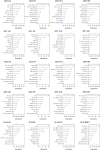Leverage machine learning to identify key measures in hospital operations management: a retrospective study to explore feasibility and performance of four common algorithms
- PMID: 39367415
- PMCID: PMC11451234
- DOI: 10.1186/s12911-024-02689-8
Leverage machine learning to identify key measures in hospital operations management: a retrospective study to explore feasibility and performance of four common algorithms
Abstract
Background: Measures in operations management are pivotal for monitoring and assessing various aspects of hospital performance. Existing literature highlights the importance of regularly updating key management measures to reflect changing trends and organizational goals. Advancements in machine learning (ML) have presented promising opportunities for enhancing the process of updating operations management measures. However, their specific application and performance remain relatively unexplored. We aimed to investigate the feasibility and effectiveness of using common ML techniques to identify and update key measures in hospital operations management.
Methods: Historical data on 43 measures on financial balance and quality of care under 4 categories were retrieved from the BI system of a regional health system in Central China. The dataset included 17 surgical and 15 non-surgical departments over 48 months. Four common ML techniques, linear models (LM), random forest (RF), partial least squares (PLS), and neural networks (NN), were used to identify the most important measures. Ordinary least square was employed to investigate the impact of the top 10 measures. A ground truth validation compared the ML-identified key measures against the humanly decided strategic measures from annual meeting minutes.
Results: For financial balancing, inpatient treatment revenue was an important measure in 3/4 years, followed by equipment depreciation costs. The measures identified using the same technique differed between years, though RF and PLS yielded relatively consistent results. For quality of care, none of the ML-identified measures repeated over the years. Those consistently important over four years differed almost entirely among four techniques. On ground truth validation, the 2016-2019 ML-identified measures were among the humanly identified measures, with the exception of equipment depreciation from the 2019 dataset. All the ML-identified measures for quality of care failed to coincide with the humanly decided measures.
Conclusions: Using ML to identify key hospital operational measures is viable but performance of ML techniques vary considerably. RF performs best among the four techniques in identifying key measures in financial balance. None of the ML techniques seem effective for identifying quality of care measures. ML is suggested as a decision support tool to remind and inspire decision-makers in certain aspects of hospital operations management.
Keywords: Exploratory study; Hospital operations management; Key management measure; Machine learning.
© 2024. The Author(s).
Conflict of interest statement
The authors declare no competing interests.
Figures
Similar articles
-
Predicting conversion of ambulatory ACDF patients to inpatient: a machine learning approach.Spine J. 2024 Apr;24(4):563-571. doi: 10.1016/j.spinee.2023.11.010. Epub 2023 Nov 21. Spine J. 2024. PMID: 37980960
-
Can Machine Learning Algorithms Predict Which Patients Will Achieve Minimally Clinically Important Differences From Total Joint Arthroplasty?Clin Orthop Relat Res. 2019 Jun;477(6):1267-1279. doi: 10.1097/CORR.0000000000000687. Clin Orthop Relat Res. 2019. PMID: 31094833 Free PMC article.
-
Evaluating the performance of machine learning methods and variable selection methods for predicting difficult-to-measure traits in Holstein dairy cattle using milk infrared spectral data.J Dairy Sci. 2021 Jul;104(7):8107-8121. doi: 10.3168/jds.2020-19861. Epub 2021 Apr 15. J Dairy Sci. 2021. PMID: 33865589
-
Data-driven modeling and prediction of blood glucose dynamics: Machine learning applications in type 1 diabetes.Artif Intell Med. 2019 Jul;98:109-134. doi: 10.1016/j.artmed.2019.07.007. Epub 2019 Jul 26. Artif Intell Med. 2019. PMID: 31383477 Review.
-
Evaluation of venous thromboembolism risk assessment models for hospital inpatients: the VTEAM evidence synthesis.Health Technol Assess. 2024 Apr;28(20):1-166. doi: 10.3310/AWTW6200. Health Technol Assess. 2024. PMID: 38634415 Free PMC article.
References
-
- (2022, December 22). Data-Driven Decision-Making for Health Administrators - School of Public Health. School of Public Health. https://publichealth.tulane.edu/blog/data-driven-decision-making/
-
- Rahimi H, Khammarnia M, Kavosi Z, Eslahi M. Indicators of hospital performance evaluation: a systematic review. Int J Hosp Res. 2014;3:199–208.
MeSH terms
Grants and funding
LinkOut - more resources
Full Text Sources



